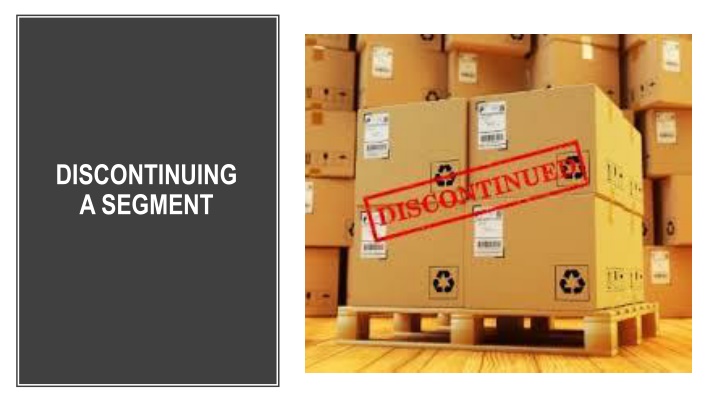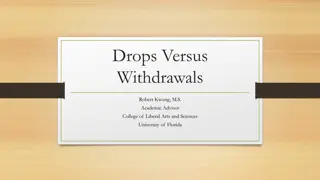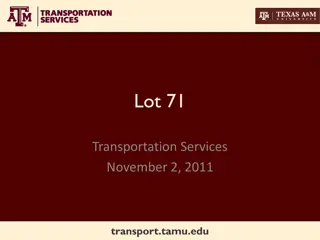
Business Segment Decision Making: Relevant Information and Cost Analysis
Making strategic decisions on whether to continue or discontinue a business segment involves analyzing relevant information such as revenues, costs, and potential impacts on other segments. This detailed case study explores the process of evaluating segments, making add-or-drop decisions, and considering various factors to determine the most appropriate course of action.
Download Presentation

Please find below an Image/Link to download the presentation.
The content on the website is provided AS IS for your information and personal use only. It may not be sold, licensed, or shared on other websites without obtaining consent from the author. If you encounter any issues during the download, it is possible that the publisher has removed the file from their server.
You are allowed to download the files provided on this website for personal or commercial use, subject to the condition that they are used lawfully. All files are the property of their respective owners.
The content on the website is provided AS IS for your information and personal use only. It may not be sold, licensed, or shared on other websites without obtaining consent from the author.
E N D
Presentation Transcript
DISCONTINUING A SEGMENT
TYPE OF CUSTOMER GEOGRAPHICAL REGION DISTRIBUTION CHANNEL DEPARTMENT OR ANY OTHER PART OF BUSINESS PRODUCT SEGMENT Some segments are underperformed compared to others managers have to decide whether to continue to discontinue the production or operation of that segment. A decision to continue, to discontinue a segment, or to start a new one is called an add-or-drop decision / add-or-delete decision.
RELEVANT INFORMATION TO CONTINUE OR DISCONTINUE A SEGMENT Relevant information includes the revenues and costs which are directly related to a segment. Irrelevant information such as allocated fixed overhead will be excluded because allocated fixed overhead will not be eliminated even if the product line or department is dropped. Other information to be considered: Does the segment have a positive contribution margin? Can any of the fixed costs be avoided if the segment was discontinued? Can the freed up capacity be used for another purpose? Will discontinuing a segment have adverse effects on the sale or revenue of other segments?
Parquet 125,000 46,000 79,000 Vinyl 87,500 35,000 52,500 Tiles 37,500 18,000 19,500 Sales Variable Cost of sales Contribution margin Less: Fixed expenses Staff Salaries General expenses Electricity Managers salaries Miscellaneous Rent Net Profit: Increase 20% / 5% Increase when sales increase 7,200 8,000 4,500 6,000 1,500 7,500 44,300 4,800 5,600 4,500 6,000 1,360 7,500 22,740 4,500 2,400 4,500 6,000 980 7,500 (6,380) Laid off redundancy payment Total Reduce 25% - allocate to P & V Avoidable Reassigned to P 75% avoidable, 25% allocate to P&V Avoidable Mis exp increase P (15%) V (10%) 1. Two workers in the Tiles Store will be laid off and they will be paid RM6,000 as redundancy payment in total. 2. The general expenses are allocated based on sales revenue. If the Tiles Store is closed, the total general expenses can be reduced by 25%. 3. 75% of the Tiles Store's miscellaneous expenses are avoidable. The rest of the expenses will be absorbed by the Parquet Store (80%) and the Vinyl Store (20%). Meanwhile, the miscellaneous expenses of the Parquet Store and Vinyl Store will increase by 15% and 10% respectively. This is due to increase in sales of Parquet Store and Vinyl Store by 20% and 5% respectively when the Tiles Store is closed down. 4. The manager of the Tiles Store can be reassigned to the Parquet Store because the sales of the Parquet Store are expected to increase. 5. Electricity and rent costs can be avoided if the store is closed.
Parquet 125,000 46,000 7,200 8,000 4,500 6,000 1,500 7,500 Vinyl 87,500 35,000 4,800 5,600 4,500 6,000 1,360 7,500 Tiles 37,500 18,000 4,500 2,400 4,500 6,000 980 7,500 Total 250,000 99,000 16,500 16,000 13,500 18,000 3,840 22,500 Sales Variable Cost of sales Staff Salaries General expenses Electricity Managers salaries Miscellaneous Rent Increase 20% / 5% Increase when sales increase Laid off redundancy payment Total Reduce 25% - allocate to P & V Avoidable Reassigned to P 75% avoid, 25% alloc to P(0.8)&V(0.2) Avoidable Mis exp increase P (15%) V (10%) Parquet Vinyl Sales Var COSales Staff salaries General exp. Electricity Mgr salary Misc exp Rent 1.2 x 125,000 = 150,000 1.2 x 46,000 = 55,200 7,200 0.75 x 16,000 x (150,000 / 241,875) = 7,442 4,500 6,000 + 6,000 = 12,000 (1.15 x 1,500 ) + (0.25 x 980 x 0.8) = 1,921 7,500 1.05 x 87,500 = 91,875 1.05 x 35,000 = 36,750 4,800 0.75 x 16,000 x (91,875 / 241,875) = 4,558 4,500 6,000 (1.1 x 1,360) + (0.25 x 980 x 0.2) = 1,545 7,500
Analysis Differential Analysis Without Tiles Store Vinyl 150,000 55,200 With Tiles Total 250,000 99,000 151,000 Difference Parquet Total 241,875 91,950 149,925 Sales (-) VCOS Contribution margin (-) Fixed cost: Staff salaries General expenses Electricity Manager salaries Miscellaneous Rent Redundancy payment Net Profit 91,875 36,750 (8,125) (7,050) (1,075) 7,200 7,442 4,500 12,000 1,921 7,500 4,800 4,558 4,500 6,000 1,545 7,500 12,000 12,000 9,000 18,000 3,466 15,000 6,000 74,459 16,500 16,000 13,500 18,000 3,840 22,500 (4,500) (4,000) (4,500) - (374) (7,500) 6,000 13,779 60,660 Decision: To discontinue Tiles Store Reason: The profit of the company will increase by RM13,779 if Tiles Store is discontinued.
Whether the sales in other department are affected by the decision. Interest and welfare of the employee who are being terminated due to discontinuation of segment. QUALITATIVE QUALITATIVE FACTORS TO FACTORS TO BE BE CONSIDERED CONSIDERED Losing established customers to competitors due to discontinuation of the segment. Unused plant and machinery in the segment being discontinued. Image of the company when it discontinues a segment.



















